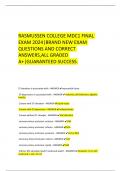RASMUSSEN COLLEGE MDC1 FINAL
EXAM 2024|BRAND NEW EXAM
QUESTIONS AND CORRECT
ANSWERS,ALL GRADED
A+|GUARANTEED SUCCESS.
ST elevation is associated with - ANSWER-✔myocardial injury
ST depressions is associated with - ANSWER-✔ischemia, old infarction, digitalis
toxicity
Q wave with ST elevation - ANSWER-✔acute injury
Q wave with ST depression - ANSWER-✔indeterminate
Q wave without ST changes - ANSWER-✔old infarction
coronary artery occlusion: anterior - ANSWER-✔LAD
coronary artery occlusion: inferior - ANSWER-✔RCA
coronary artery occlusion: posterior - ANSWER-✔LCX or RCA
Coronary Artery Occlusion: lateral - ANSWER-✔LCX
coronary artery occlusion: septal - ANSWER-✔LAD
Inferior MI: elevation leads? reciprocal leads? - ANSWER-✔elevation: II, III, aVF.
reciprocal: I, aVL, V1-V4
, anterior-septal MI: elevation leads? reciprocal leads? - ANSWER-✔elevation: V1-V4.
reciprocal: II,III, aVF, aVL
Lateral MI: elevation leads? reciprocal leads? - ANSWER-✔elevation: I, aVL, V5, V5.
reciprocal: II, III, aVF
Posterior MI: elevation leads? reciprocal leads? - ANSWER-✔elevation: V6.
reciprocal: V1-V4
Junction (J) Point - ANSWER-✔end of QRS & beginning of ST segment where QRS
stops and makes a sudden SHARP change of direction
Delta wave is associated with - ANSWER-✔Wolff-Parkinson White Syndrome
where is the delta wave on EKG - ANSWER-✔Bump in the beginning of the QRS
wave
Osborne wave is associated with - ANSWER-✔Hypothermia
Peaked/tented T waves indicate - ANSWER-✔hyperkalemia
Peaked P waves/ flattened T waves/ U waves indicate - ANSWER-✔hypokalemia
Wide QRS could indicate x2 - ANSWER-✔BBB present, TCA overdose
Prolonged QT interval could indicate - ANSWER-✔TCA overdose
history of tricyclic antidepressant overdose can exhibit what ECG tracing - ANSWER-
✔prolonged QT interval
what is the amount of blood in the ventricles at end-diastole - ANSWER-✔Preload
(right= CVP, left= PAOP)
what is the resistance the ventricles must overcome to eject blood into the
pulmonary and systemic circulation - ANSWER-✔afterload (SVR)
Stroke volume is dependent on - ANSWER-✔contractility, preload, afterload
sequence blood flows throughout the heart valves - ANSWER-✔Tricuspid, Pulmonic,
Mitral, Aortic
common site affected for balloon dislodgment when treating your IABP patient -
ANSWER-✔left radial
contraindication for IABP - ANSWER-✔aortic aneurysm, aortic insufficiency, aortic
stents, AAA
, "rust-colored flakes" in IABP tubing indicated - ANSWER-✔balloon rupture
how to determine early or late inflation in IABP - ANSWER-✔draw line from dicrotic
notch to inflation point
if the inflation point (IP) is 2mm+ from the dicrotic notch (DN), it indicates -
ANSWER-✔early inflation
primary trigger used from most IABP operations is the - ANSWER-✔EKG
IABP balloon inflation on EKG starts at - ANSWER-✔middle of T wave
IABP balloon deflation on EKG prior to - ANSWER-✔end of QRS complex
IABP inflation mechanism occurs at - ANSWER-✔onset of ventricular diastole
IABP deflation mechanism occurs at - ANSWER-✔prior onset of ventricular systole
which patients are not affected with altitude temperature changes - ANSWER-
✔cardiac patients
therapy focus for left ventricular heart failure patients - ANSWER-✔diuretics and
relief of anxiety
characteristics of systolic failure - ANSWER-✔<65 y/o , frequent/prior MI, S3 heart
tone, cardiomegaly present
characteristics of diastolic failure - ANSWER-✔>70 y/o, common in women,
frequent hx of HTN, S4 heart tone, no cardiomegaly
BP MAP formula - ANSWER-✔-(2xDBP) + SBP / 3
coumadin overdose antidote - ANSWER-✔vitamin K, FFP
Medication NOT to give cardiogenic shock and CHF patients - ANSWER-✔Beta-
blockers
medications for cardiogenic shock - ANSWER-✔vasodilator and positive inotropes
treatment for decompensating bradydysrythmias (FAEDE) - ANSWER-✔fluids,
atropine, external pacing, dopamine, epinephrine
S/S decompensating bradydysrythmias - ANSWER-✔SBP <90 AMS
medication NOt to give decompensating bradydysrythmias with 2nd degree HB type
II or CHB or heart transplant - ANSWER-✔atropine




